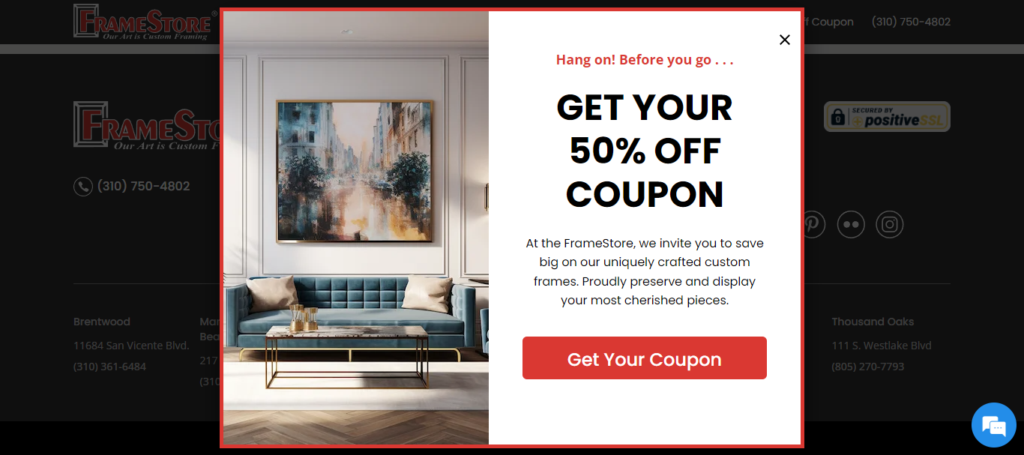Your top competitors are always hunting for new ways to attract and convert your target customers.
While content marketing basics lay an essential foundation, you need more oomph to create a competitive edge.
In other words …
To truly stand out from high DA sites vying for top-ranking positions and opt-ins …
You need to embrace trending content marketing strategies that focus on customer-centricity.
Content formats that put you or your product front and center send your audience the wrong message.
Why?
Your potential customers crave personalized user experiences.
The kinds that put them in the driver’s seat and lead them to the exact solutions they need.
They don’t want to hear why your product or service is great. They want to know how they can experience greatness after the benefits your solution or information gives them.
Thankfully, by following emerging content marketing trends, brands and content creators can give prospects the tailored experiences they desire.
Let’s take a closer look at nine content marketing trends you can implement in 2025 to build meaningful relationships with your target audience.
Irresistible lead magnets
Use captivating lead magnets to build your lead list and automate segmented email campaigns.
A lead magnet is a piece of content or offer that you gate in exchange for a prospect’s contact information. Typically, their name, email address, and maybe their phone number.
For instance, FrameStore, a custom frames store in LA, offers prospects a generous 50% coupon in exchange for their opt-in:

And Nlyte, a Data Center Infrastructure Management (DCIM) software company, offers leads a Free DCIM for Dummies ebook in exchange for their contact details:
When considering lead magnet approaches …
Use data to uncover the content assets and offers your audience values most.
For instance, if you run a SaaS company, you might learn that your leads flock toward 30-day free trial offers and webinar invitations. Or, if you run an ecommerce store, you might discover that your prospects value downloadable gift guides and buy-one-get-one (BOGO) deals.
Similarly, brands targeting specific niche audiences, such as those focused on men’s wellness, might find that content addressing very specific concerns, such as tips on how to cum more, backed by research and practical advice, can be highly effective lead magnets.
Be sure to A/B test your lead magnet ideas before scaling campaigns. Finalize the campaigns that test the best across multiple marketing channels.
For instance, consider featuring lead magnets:
- In affiliate and influencer marketing campaigns
- In social media ads and posts
- On relevant landing pages
- On your home page
- In PPC ads
Dynamic filters
If your product or solution offers robust features or customization options, create an immersive experience grounded in personalization.
For instance, dynamic filters can help website visitors hone in on tailored clothing options or find the right monthly subscription plan.
Take StudioSuits, a brand that sells tuxedo suits, as an example.
On its site, online visitors can apply dynamic filters to personalize their shopping experiences:
Users can choose individual jacket and trouser sizes and explore through generous swatch options by color, design, and fabric:
Before setting up dynamic filters on your site, categorize your feature, plan, or product options. Go as micro as you can here to give visitors plenty of customization options.
Then, set up dynamic filters on appropriate pages.
For instance, you might set up SaaS dynamic filters on your plans and pricing page and at the top of your home page.
Interactive content
Similar to dynamic filters, interactive content helps prospects tailor their shopping experiences.
It puts the purchasing power in their hands so they can walk away with a curated solution.
Tailor Brands’ free AI Logo Maker is a great example:
After entering a brand name and following the auto-generated prompts, aspiring entrepreneurs can use the tool to customize their business logos.
At the end of the prompt choices, the tool uses AI to generate a main logo, along with other brand elements:
But …
In order to see the final logo and associated design elements, the user must sign up to receive emails from Tailor Brands. A quick sneak preview captivates the lead and nudges them to opt in to receive their results.
Hint: If you sell any AI apps, this strategy is for you!
Guided selling experiences
If you’re a service provider in the telehealth industry or have an ecommerce store, guided selling is a fantastic trend to embrace in 2025.
These discovery “quizzes” help brands uncover the user’s core problem so they can offer a custom solution.
Hers, for instance, uses guided selling experiences to help visitors receive personalized support for their hair loss, mental health, skin — and other wellness priorities:
After the quiz, Hers assigns a specific online physician, wellness protocol, and sometimes a prescription to the user.
However, to receive their personalized plan and start treatment, they’ll need to provide their email address.
If the lead doesn’t sign up for telehealth services after opting in, Hers continues nurturing them with segmented emails.
To create your quizzes, jot down an overview of your products and services. Then, outline the specific options you offer for each — and the pain points they solve.
Turn these notes into a comprehensive guided selling experience. Use a form builder or discovery quiz builder to make these, or hire a quiz maker.
Set up lead nurturing sequences before you launch your quizzes. This is pivotal to helping you automate the follow-up process if your leads don’t convert after taking the quiz. Some prospects are happy to join your list but will need more nurturing before becoming a customer.
Video marketing
From short-form videos to user-generated content, videos will captivate audiences in 2025.
To maximize content marketing efforts, brands are pairing video content with influencer marketing campaigns.
For example, Cruise America, an RV rental company, embraces video and supercharges it through collaborations. It leverages both micro-influencers and excited customers, creating authentic, relatable content that resonates with its audience:
By scaling user-generated video content, you not only put your brand in front of more qualified buyers but also collect endless social proof.
Embed positive brand mentions across sales pages, on your website, and in other marketing campaigns to build trust.
Other video content marketing trends include:
- Video assets to support blog posts
- Video sales messages via email
- Video ads (especially on social)
- Employee ambassador videos
- Video social media Stories
- Interactive videos
Social media carousel guides
Social media posts have become perfect opportunities for deep insights and long-form content.
Especially on Instagram and LinkedIn.
If you’re in the education or B2B space, social media carousel guides can help you deliver insightful, thought-leadership content.
Jeremy Moser, the CEO at uSERP, for example, creates carousel guides to help prospects learn about digital PR and SEO strategies:
These assets not only help Jeremy’s audience solve problems. They also help position Jeremy — and uSERP — as trusted industry authorities.
To follow in Jeremy’s footsteps, focus on topics that matter most to your core audience. Dig deep into search intent and deliver valuable insights grounded in personal expertise.
Share solutions that can change their lives or businesses for the better. Consider ending carousels with relevant calls to action (CTAs) so you can generate qualified leads.
Immersive content experiences
Give your audience a complete digital experience by letting them test-drive or “try on” your product.
Playing into virtual reality, immersive content experiences show your audience what “done” or “up close” looks like.
For instance, if you run an online clothing store, you can create an immersive experience that allows visitors to try on clothes — virtually.
Other common industry examples include real estate services and jewelry companies. A jewelry marketing company can help brands incorporate immersive technologies to enhance the online try-on experience and drive engagement.
For instance, Virtual Staging AI helps real estate professionals stage their properties with virtual furniture:
Clean Origin offers 3D magnification experiences, so shoppers can see ornate jewelry details up close:
To create an immersive experience, consider creating your own AI tool or using existing AI apps to take visitors on a journey.
Focus on showing them what the creation process or “done” looks like when using your service or product.
Variety of SEO approaches
Pleasing search engines and competing for quality, organic traffic isn’t going away — it’s expanding.
While traditional text search remains important …
Capitalizing on other SEO trends is also vital as technology ramps up.
These include optimizing for:
- Google’s new AI search
- Social media searches
- Mobile search
- Voice search
Topic clusters also continue to play an important role in your 2025 SEO strategy.
Not only do they catalog your blog content, but they also help search engine spiders better understand your:
- Specific expertise
- Target audience
- Authority level
- Content focus
- Industry
- Niche
And speaking of expertise …
A hyper-focus on Google’s acronym “E-E-A-T” will emerge in 2025.
In case you’re unfamiliar, the term stands for Experience, Expertise, Authoritativeness, and Trustworthiness.
By following this framework, you can create helpful content that fills in competitor gaps and helps you establish your company as a valued thought leader.
Some examples of building authority using E-E-A-T may include:
- Guest-posting to generate quality do-follow backlinks
- Sharing subject-matter-expert insights
- Publishing original research
- Creating owned media
Hybrid content creation
Content marketing teams are creating content at scale in 2025 with artificial intelligence tools.
But …
It’s not what you think.
Instead of relying solely on AI-generated content, ethical teams are prioritizing a healthy hybrid approach.
In other words, they’re using AI to focus on simple or mundane tasks, such as:
- Brainstorming
- Scripting
- Outlining
- Defining
- Briefing
And they’re using human writers to focus on more creative tasks, like:
- Sharing personal and subject-matter expertise
- Providing thought leadership
- Sharing valuable examples
- Collecting original research
- Storytelling
.
By striking the right balance between AI and human writers, you can scale content across your marketing channels without sacrificing quality.
*Pro-Tip: Meet with your team to test AI content tools across mock campaigns. After testing, integrate your final AI tech stack into your content marketing processes and workflows.



